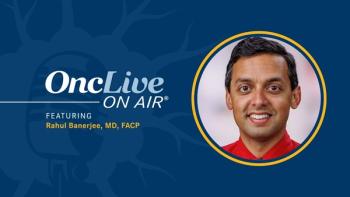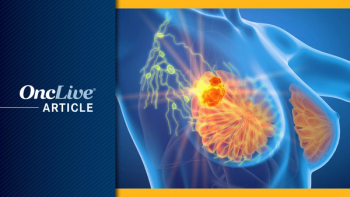
- Vol. 20/No. 22
- Volume 20
- Issue 22
Erdafitinib Tackles an Unmet Need in Urothelial Carcinoma
As the first targeted therapy in bladder cancer, erdafitinib (Balversa) expands the limited treatment options for the subset of patients with urothelial carcinoma.
Arlene O. Siefker-Radtke, MD
As the first targeted therapy in bladder cancer, erdafitinib (Balversa) expands the limited treatment options for the subset of patients with urothelial carcinoma who harbor FGFR3 or FGFR2 genetic alterations. In results from a phase II clinical trial (NCT02365597), erdafitinib demonstrated a robust response rate and was tolerable in a population with a typically poor prognosis, said Arlene O. Siefker-Radtke, MD.
In an interview with OncologyLive®, Siefker-Radtke, a professor in the Department of Genitourinary Medical Oncology at The University of Texas MD Anderson Cancer Center in Houston and a leading investigator in the pivotal BLC2001 trial, discussed the role erdafitinib will play in shaping the treatment paradigm for patients with FGFR alterations.
OncologyLive: Could you please provide an overview of the patient population eligible for this drug?
Siefker-Radtke: Erdafitinib is currently approved in the second-line setting following some form of frontline chemotherapy. This could be chemotherapy for metastatic disease or it could be recurrences within 1 year of neoadjuvant or adjuvant chemotherapy. Patients do not have to have failed prior immunotherapy to go on treatment with erdafitinib. The other thing to consider with the patient population is that these patients have to have a known FGFR3 or FGFR2 alteration.
Can you discuss the efficacy data that led to the approval of erdafitinib?
The clinical trial met its objective, with a 40% objective response rate. There were additional patients who had a reduction in the size of their tumor that was not of the extent to be a partial or complete remission. So, about 70% of patients, or slightly over that in all, had some reduction in size of their cancer. The median overall survival was promising as well. The median overall survival was 13.8 months, which is quite good in the second-line setting when you consider the impact of single-agent taxanes and the impact of immunotherapy.
By both response and objective survival, this treatment does appear very promising. And the trial did meet its primary endpoint of objective response rate.
Can you describe the mechanism of action?
Erdafitinib is an oral agent, and it is an inhibitor of activating FGFR3 receptor alterations. It works in the active kinase region for FGFR3, blocking the effectiveness on tumor cells, and unlike other TKIs [tyrosine kinase inhibitors] in kidney cancer, this had both cytoreductive in addition to some cytostatic effects. That’s why we are seeing responses in 40% of patients.
What else do we know about erdafitinib’s tolerability?
At the time this therapy was being developed, the other FGFR inhibitors that have been studied to date, particularly dovitinib and the compound BGJ398 [infigratinib], could only be given on an intermittent schedule because of toxicity. So, when we were designing this trial, we initially randomized patients on either an intermittent schedule of either 10 mg [daily] 1 week on, 1 week off or a continuous schedule of 60 mg daily. After evaluating a group of patients based on toxicity and the potential for activity, the continuous dose was selected for further accrual for the phase II portion.
We found we were able to increase that daily dose to an 8-mg daily dose, and then with additional testing, [we] found that 9 mg may be optimal for a portion of patients. After starting an 8-mg daily dose, on day 15 or 14, phosphorous levels were checked, and if they were <5.5 mg/dL, then the patient was increased from an 8-mg daily dose to a 9-mg daily dose.
As expected with other FGF [fibroblast growth factor] inhibitors, we did see hyperphosphatemia, although we were actually pushing toward hyperphosphatemia since we thought that would indicate appropriate suppression of FGFR3. Otherwise, it has other similar adverse effects to other TKIs. We see a bit of hand-foot syndrome, we see nail changes, a bit of dry mouth, dry skin, dry eyes.
One of the adverse events of special interest is central serous retinopathy, which has been reported with other inhibitors of the MAP kinase pathway, so all patients have a baseline OCT [optical coherence tomography] testing by ophthalmology. Then we did Amsler grid monitoring, and if patients reported any changes in the grid lines or blurred vision, we would send them back to ophthalmology, hold the therapy, and test to see whether central serous retinopathy was present.
Even in patients in whom it was present, many, after holding the dose, were able to resume treatment. Overall, it did appear relatively well tolerated compared with historical data with cisplatin.
How does erdafitinib fit into the current treatment paradigm?
Until erdafitinib’s approval, there were only 2 classes of treatment approved. One was platinum-based chemotherapy, and then in patients who failed platinum, [there was] immune checkpoint inhibitor therapy. Immune checkpoint inhibitors were also approved for patients who were cisplatin ineligible but had [positive] PD-L1 expression. The treatment options have truly been quite limited. Erdafitinib brings to the table a new oral agent, the first targeted agent for FGFR3, and the first personalized therapy for the treatment of urothelial cancer.
What are the next steps for erdafitinib?
There have been some interesting data suggesting that urothelial tumors with FGFR3 alteration appear immunologically cold and may not respond as well to immunotherapy. When we looked at patients on this trial who received prior immunotherapy, there were 22 patients, and only 1 out of those 22 patients had an investigator-reported response to their immune checkpoint inhibitor. One thought is that this could reflect an unmet need, and it raised the question: Might FGFR-alerted urothelial tumors benefit more from treatment with an FGF inhibitor compared with an immune checkpoint inhibitor?
The phase III confirmatory trial, which is called THOR [NCT03390504], takes patients who have failed prior chemotherapy, either in the metastatic setting or within 12 months of neoadjuvant or adjuvant chemotherapy, and randomizes them to either erdafitinib or an immune checkpoint inhibitor. If a patient has already received an immune checkpoint inhibitor, they may go on treatment, but they are in a second group of patients who are randomized between FGF inhibition or a taxane.
There is also a second trial called NORSE [NCT03473743], which combines erdafitinib with immunotherapy. The hypothesis is that the use of FGFR3 inhibition may take this immunologically cold tumor and make it more susceptible to an immune response; combining with an immune checkpoint inhibitor may enhance the clinical activity of both. This trial is a phase I/II trial, and in the phase II portion, the patients are randomized front line to either erdafitinib or erdafitinib with an immune checkpoint inhibitor.
Articles in this issue
about 6 years ago
Yale Radiation Oncologist Searches for the Elusive "Abscopal" Effectabout 6 years ago
Emerging Immunotherapy Combos Seek to Capitalize on the Powers of RTabout 6 years ago
ASCO Guidelines on VTE Add New Oral Agentsabout 6 years ago
Novel Therapy May Boost Efficacy of Chemotherapy Backbone in mCRCabout 6 years ago
New Therapies Set Stage for Dramatic Changes in Bladder Cancerabout 6 years ago
Guardrails Keep Oncology Waste Management on the Right Trackabout 6 years ago
Wearable Health Tech Faces Hurdles in Oncologyabout 6 years ago
The Armamentarium of Biosimilars Becomes More Robust
























































































